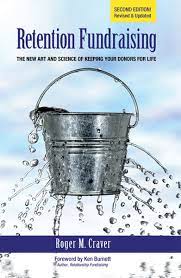- Home
- About Us
- The Team / Contact Us
- Books and Resources
- Privacy Policy
- Nonprofit Employer of Choice Award

 I’ll never forget the little old lady.
I’ll never forget the little old lady.
Early in my career I called on her to discuss the college’s plan for a new library, hoping she’d become a major contributor.
She served tea and little cucumber sandwiches. We chatted amiably and then got down to business. With great enthusiasm I showed her the architect’s schematics, explained why it was a sound idea to raze the old dorm that had stood for ninety years, and how attractive the new library would be in its place.
My confidence grew as she took it all in. She asked bright, incisive questions and didn’t wince when I suggested the amount of a gift that would represent her share of the project.
“Young man,” she said as I concluded, “I’m very impressed. But I won’t be contributing to this project.”
I was startled. “May I ask why not?”
“Well, you see, I’m all in favor of progress, but I’m absolutely opposed to change.”
All too many of our organizations are like that little old lady. We claim we’re in favor of income growth and a sustainable future. But in practice we ignore the huge fundraising changes that threaten both.
We blithely continue doing the same old things, ignoring the eventual and inevitable day of reckoning.
Surprise! That day has already arrived.
Year after year for the past decade, donor-retention rates have been sinking. Today they’re at an all-time low.
In a 2013 study by the Association of Fundraising Professionals, only 65 of the 2,377 organizations surveyed had a retention rate over 70 percent! (Sadly, the study contained no profiles of the 65 high-retention organizations.)
That same study also found:
Flat Fundraising. Every $100 raised from new donors was offset by $100 in losses.
Negative growth in the number of donors. For every 100 donors acquired, 107 were lost through attrition.
Small organizations suffering most. On average, charities raising more than $500,000 lost $90 for every $100 raised. Those raising between $100,000 and $500,000 lost as much as they gained. And organizations raising $100,000 or less lost $110 for every $100 raised.
In brief, the days of the seemingly infinite pool of new donors available to quickly and inexpensively replace those who’ve stopped their support are long gone.
Today, as more and more donors abandon ship, the cost of replacing them has grown so great as to be no longer affordable for most nonprofits.
It doesn’t have to be this way. Consider this:
The average nonprofit has a 60–70 percent chance of obtaining additional contributions from existing donors; a 20–40 percent probability of securing a gift from a recently lapsed donor; but less than a 2 percent chance of receiving a gift from a prospect.
With these figures in tow, you’d think we’d be pouring the bulk of our marketing and fundraising dollars into retaining donors, rather than laying out large sums to acquire more and more new ones.
But sadly we’re not. Too many of our boards, CEOs, and fundraisers haven’t accepted the new reality of a world that’s never going to return to the good old days.
Fortunately, there is good news. There’s a proven process now for increasing donor retention—for plugging the holes in the bucket through which our donors are pouring.
This process outlined in this book is based on empirical evidence we gathered in partnership with Kevin Schulman and his team at DonorVoice.
By understanding and putting this process to work, we can add tens of thousands or even millions of dollars to our organizations’ bottom lines.
All that’s required is adopting new mindsets, new metrics, and new methods—all of which we can learn quickly and start to apply immediately.
There are two metrics that are especially important—retention rate and lifetime value (LTV). These are fundamental measures of how well your organization is performing in the eyes of donors.
This excerpt is taken from Retention Fundraising, newly updated Second Edition reprinted by Civil Sector Press.